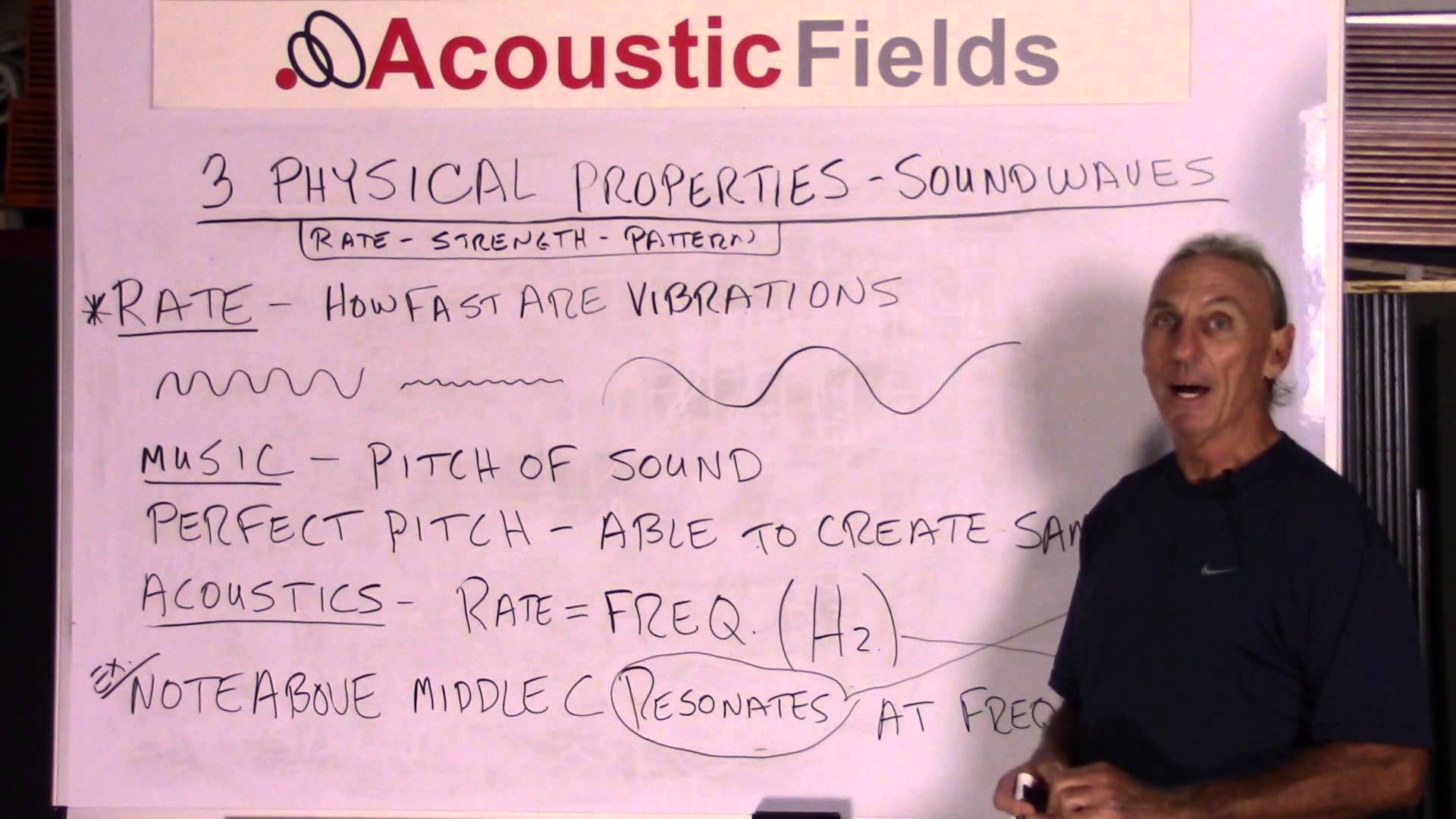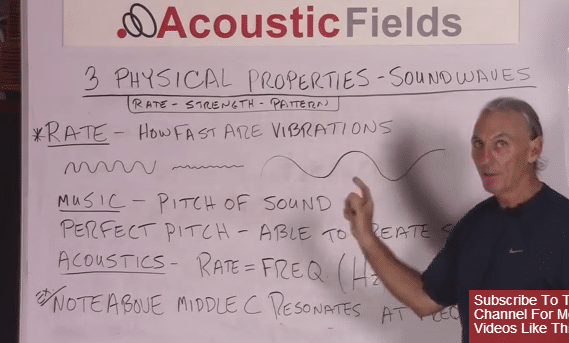I think every now and then we should take a deep breath, step back and get back to basics and just look at some definitions of terms and how they interrelate with each other, because if we’re going to communicate in acoustics, sound, music, these are all interrelated subjects that each have their own nomenclature, their own vernacular. There’s a lot of overlap for sure but it’s the understanding of the differences that separates the paradigms that we use to process all this information and acoustics is complicated in and of itself. So I think it’s good every now and then to go back and look at some basics, so let’s do that today with room acoustics 101 – the physical properties of sound waves.
The 3 physical properties of sound waves
Today we’re going to look at the three physical properties that sound waves have. So take a minute and think about them, about their Rate, Strength and Pattern. I’m trying to make this nice and descriptive. Sometimes the words I will use are not scientific because I’m trying to illustrate the concept for you so that you’ll understand the concept without the need to understand the technical.
1. Rate
What is the rate? How fast are the vibrations? We know that all sound energy is created by something moving, something vibrating. So rate is nothing but the speed of the vibration. So if we graphically look in the below screenshot, we’ll have 3 different types of wavelengths, where the distance between the peak and the trough are tighter or longer. This all speaks to the rate or how fast are the vibrations.
Now here’s where the overlap starts to occur and here’s where the confusion also arises. In music we refer to that rate as the pitch of the sound. You’ve heard of musicians having perfect pitch, well what are they able to do in terms of vibrations? They’re able to take their vocal cords and achieve the same rate, thus the same rate of the sound translates to pitch in music.
In acoustics we really don’t care about any of that. We do when we’re breaking down the technologies to use in a room for articulation, however it’s not that big of a process for us as it is in music.
How do we express this? Everybody knows this term, it’s expressed in frequencies, and the term we use is Hertz and we all are familiar with that one. So rate is how fast are the vibrations, in music it’s the pitch, in acoustics it’s expressed in terms of frequency and frequency is heard a lot about.
Now if we take all this and we add it into a sentence and try and tie everything together let’s see what it looks like. So we could say as an example, any note above middle C resonates at a frequency of four hundred forty cycles. Okay so what does that tell us? We have a rate which resonates at a particular frequency which is expressed in hertz. So I think that example kind of illustrates rate and how it moves between music and acoustics and that’s just two paradigms being considered. There are many others but I think if we look at the relationship between the disciplines, we’ll just get a better understanding and we may be able to understand it in one dimension like music but not in acoustics. Well if you just make a simple shift in your mind of how the two are correlated, you’ll be okay.
2. Strength
What is strength? Strength is the intensity of the rate of vibrations. Above we learned it was the speed and the rate of vibrations that was critical for rate well this is a measure of their strength if you will, their intensity and whenever something has strength or intensity in one area, it all has to work. It all has to fit within what you’re trying to do.
So in music what do we call that? Well the strength, which is one of the three physical properties of a sound wave is, perceived as loudness and we all have heard this term. “Well it’s loud, the music is loud, turn the music down its too loud”. So loudness is the vernacular in the perception that we use in relationship to strength.
Now in acoustics it’s kind of a different process, kind of the same but kind of different and here’s where that overlap occurs. They both kind of separate and go their own way and this is the difference that you have to realize.
In acoustics its wave strength, the amplitude, the gain, how much over acceptable baseline is it? What is the acceptable baseline? Well it depends on your room. How much energy is in the room based on the volume of the room? How much energy is being worked in a room based on the dimensions, the ratio, height, width, length? All these factors have to be considered and taken into the analysis.
How do we measure in acoustics strength and the amplitude. Well it’s in decibels so you know it’s this common one that we see, dB. So here’s a good example of where strength, in music we perceive it and use the term loudness to describe it, but in acoustics it has a whole different twist and a whole different process involved to it so one kind of forms the basis for the other.
3. Pattern
Pattern or the signature of the radiant strength that we’ve talked about. So that’s the shape, the wave form, the pattern that it takes. Sixty cycles is different than two thousand so they do have different shapes, different forms. The simplest, and we’ve all heard this term before, is the sine wave, that’s the simplest of all the waves of all this.
Now back to the differences between acoustics and music that we’re using for comparison purposes here, for understanding. So in music, what is music? Music is multiple sine waves, many different sine waves to produce music. In acoustics, what is a sine wave? It’s really a test signal force. So there are your differences. Because one is multiple sine waves to produce something and then we are testing for that multiplicity if you will, using just one frequency. So think about that and we’ll talk about that in a future video.
In Summary
I hope this room acoustics 101 discussion has been helpful. Please leave any comments below so I can get back to you. Don’t be afraid to hit those Facebook like, Google+ and Twitter buttons on the left hand side so other people can see this post. And if you want to learn more about this subject please sign up for our free room acoustic treatment videos and ebook which provide step by step instructions. Get instant access by signing up now. And if you would like your room acoustic issues analysed for free by me then please fill in the form here and I will be happy to take a look for you.
Thanks
Dennis








